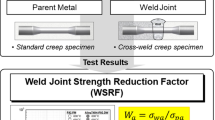Abstract
The early cracking of dissimilar metal welds (DMWs) between T91 martensitic steel and austenitic steel in a 1000-MW ultra-supercritical power plant was investigated in this article. Optical microscopy and scanning electron microscopy were used to characterize the microstructures of DMWs. The result shows that the breakdown of DMWs was brittle rupture along the prior austenite crystal boundary. The crack extended from T91 heat-affected zone to T91 base metal. Compared with the spare DMWs, its tensile strength and bending properties met the standard for DMWs. Hardness of T91 HAZ from failed DMWs was much higher than that of spare DMWs. Some pitting was observed at the T91 HAZ. Associating the high hardness of DMWs and particular service environment, it is concluded that the failure of DMWs was caused by the stress-corrosion crack.





Similar content being viewed by others
References
C.D. Lundin, Dissimilar metal welds-transition joints literature review. Weld. J. 61(2), 58–63 (1982)
L. Collini, M. Giglio, R. Garziera, Thermomechanical stress analysis of dissimilar welded joints in pipe supports: structural assessment and design optimization. Eng. Fail. Anal. 26, 31–49 (2012)
J.N. DuPont, Microstructural evolution and high temperature failure of ferritic to austenitic dissimilar welds. Int. Mater. Rev. 57(4), 208–234 (2012)
F. Gauzzi, S. Missori, Microstructural transformations in austenitic-ferritic transition joints. J. Mater. Sci. 23(3), 782–789 (1988)
H.T. Wang, G.Z. Wang, F.Z. Xuan et al., Fracture mechanism of a dissimilar metal welded joint in nuclear power plant. Eng. Fail. Anal. 28, 134–148 (2013)
G. Chen, Y. Song, J. Wang et al., High-temperature short-term tensile test and creep rupture strength prediction of the T92/TP347H dissimilar steel weld joints. Eng. Fail. Anal. 26, 220–229 (2012)
J. Cao, Y. Gong, K. Zhu et al., Microstructure and mechanical properties of dissimilar materials joints between T92 martensitic and S304H austenitic steels. Mater. Des. 32(5), 2763–2770 (2011)
J.C. Lippold, D.J. Kotecki, Welding Metallurgy and Weldability of Stainless Steels (Wiley-VCH, Weinheim, 2005), pp. 20–21
Acknowledgments
This work is supported by the National Natural Science Foundation of China (51806166), the Innovative Talents Support Plan of China Postdoctoral Foundation (BX2019269) and the Fundamental Research Funds for the Central Universities (xjj2018064). We would like to thank anonymous reviewers for their helpful comments and suggestions in improving the paper.
Author information
Authors and Affiliations
Corresponding author
Additional information
Publisher's Note
Springer Nature remains neutral with regard to jurisdictional claims in published maps and institutional affiliations.
Rights and permissions
About this article
Cite this article
Ren, X., Liang, Z. Investigation of Early Cracking of Dissimilar Metal Welds in a 1000-MW Ultra-supercritical Power Plant Close to the Sea. J Fail. Anal. and Preven. 19, 777–781 (2019). https://doi.org/10.1007/s11668-019-00658-2
Received:
Revised:
Published:
Issue Date:
DOI: https://doi.org/10.1007/s11668-019-00658-2




